 | | | Switch to: Europe, USA, New Zealand, Antarctica Credit: NOAA/Ovation  Planetary K-index Planetary K-index
Now: Kp= quiet
24-hr max: Kp= quiet
explanation | more data
Interplanetary Mag. Field
Btotal: 6.5 nT
Bz: -1.2 nT south
more data: ACE, DSCOVR
Updated: Today at 2347 UT  Coronal Holes: 29 Jul 18 Coronal Holes: 29 Jul 18 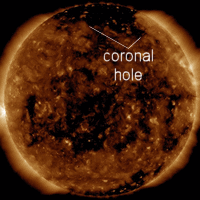
A stream of solar wind flowing from this polar coronal hole will probably sail north of Earth on July 30-31. Credit: SDO/AIA  Noctilucent Clouds The season for noctilucent clouds in he northern hemisphere is underway. Check here daily for the latest images from NASA's AIM spacecraft. Switch view: Europe, USA, Asia, Polar Updated at: 07-29-2018 13:55:02 Noctilucent Clouds The season for noctilucent clouds in he northern hemisphere is underway. Check here daily for the latest images from NASA's AIM spacecraft. Switch view: Europe, USA, Asia, Polar Updated at: 07-29-2018 13:55:02  SPACE WEATHER
NOAA Forecasts | | Updated at: 2018 Jul 29 2200 UTC FLARE | 0-24 hr | 24-48 hr | CLASS M | 01 % | 01 % | CLASS X | 01 % | 01 % |  Geomagnetic Storms: Geomagnetic Storms:
Probabilities for significant disturbances in Earth's magnetic field are given for three activity levels: active, minor storm, severe storm Updated at: 2018 Jul 29 2200 UTC Mid-latitudes | 0-24 hr | 24-48 hr | ACTIVE | 15 % | 15 % | MINOR | 05 % | 05 % | SEVERE | 01 % | 01 % | High latitudes | 0-24 hr | 24-48 hr | ACTIVE | 15 % | 15 % | MINOR | 20 % | 20 % | SEVERE | 20 % | 20 % | | | |  | | | | | | | | | | | All-inclusive Northern Lights trips in Tromsø, Norway. Small groups, big experiences! Highly qualified guides ensure unique and unforgettable adventures with a personal touch. Visit Explore the Arctic | | | SOLAR MINIMUM DEEPENS: The sun has been without sunspots for 31 of the past 32 days. To find a similar stretch of blanks suns, you have to go back to 2009 when the sun was experiencing the deepest solar minimum in a century. Clearly, solar minimum has returned, bringing extra cosmic rays, long-lasting holes in the sun's atmosphere, and strangely pink auroras. Free: Aurora alerts. A QUIET DAY ON THE SUN: Solar minimum has arrived, but even the "quiet sun" is an awesome thing. Powered by fusion, the sun is a 1027-ton nuclear explosion contained in one place only by the awesome force of its own gravity. On July 29th, Alan Friedman of Buffalo, New York, photographed the seething edge of that exploding ball: 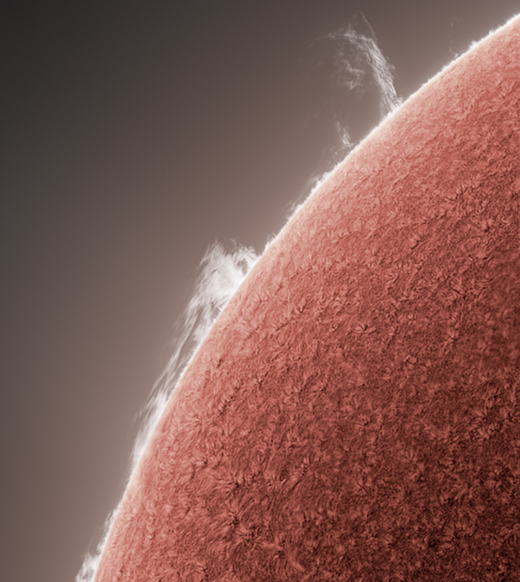
"Finally... a Sunday sun with some fireworks!" says Friedman. "There were no sunspots on the face of the sun, the action was all at the edge of the disk. It was a wonderful day to be out observing." Friedman and other observers around the world have been monitoring this prominence--a ragged magnetic filament dancing along the sun's eastern limb all weekend long. Readers, if you have a solar telescope, take a look. Realtime Space Weather Photo Gallery SOUTH POLE LUNAR ECLIPSE: Around the world, on July 27th, hundreds of millions of people watched a total eclipse of the Moon. Only a handful saw it from the bottom of the world. Robert Schwarz was one of them, and he sends this picture from Amundsen-Scott South Pole Station in Antarctica: 
"Mars is on top, the Moon is on the bottom, with a faint band of auroras cutting across them," says Schwarz, who is overwintering at the south pole for the 8th year in a row and 14th year overall. "I am currently working with a Cosmic Microwave Background experiment called SPUD/KECK. The building in the photo is MAPO (Martin A. POmerantz) which houses our telescope." "The weather definitely wasn't great for photos--quite hazy and lots of blowing snow with winds around 25 knots, but at least it was quite warm with a temperature about -45°C." This was the longest lunar eclipse of the century. The Moon spent 1 hour 43 minutes inside the sunset-colored shadow of Earth, giving sky watchers on 6 continents plenty of time for astrophotography. Browse the photo gallery for snapshots from around the world. Realtime Lunar Eclipse Photo Gallery
100,000 FEET ABOVE HOBBITON: On June 21st, the students of Earth to Sky Calculus launched a payload full of Tolkien rings on a cosmic ray balloon over the north island of New Zealand. The golden bands flew more than 100,000 feet above Hobboton, movie set for Lord of the Rings: 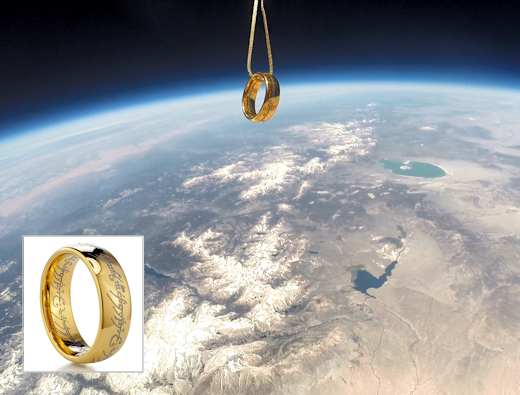
You can have one for $149.95. The students are selling these rings as a fundraiser for theirglobal radiation monitoring program. They are made of golden-colored tungsten and inscribed with the authentic Mordor script of the One Ring. Each one comes with a greeting card showing the ring in flight and telling the story of its journey to the edge of space. Far Out Gifts: Earth to Sky Store
All sales support hands-on STEM education
Realtime Aurora Photo Gallery
Realtime Noctilucent Cloud Photo Gallery Every night, a network of NASA all-sky cameras scans the skies above the United States for meteoritic fireballs. Automated software maintained by NASA's Meteoroid Environment Office calculates their orbits, velocity, penetration depth in Earth's atmosphere and many other characteristics. Daily results are presented here on Spaceweather.com. On Jul. 29, 2018, the network reported 76 fireballs.
(69 sporadics, 3 Perseids, 2 Southern delta Aquariids, 1 , 1 alpha Capricornid) 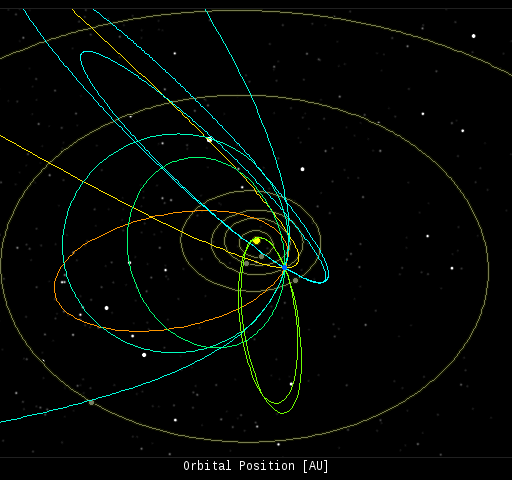 In this diagram of the inner solar system, all of the fireball orbits intersect at a single point--Earth. The orbits are color-coded by velocity, from slow (red) to fast (blue). [Larger image] [movies] Potentially Hazardous Asteroids ( PHAs) are space rocks larger than approximately 100m that can come closer to Earth than 0.05 AU. None of the known PHAs is on a collision course with our planet, although astronomers are finding new ones all the time. On July 29, 2018 there were 1912 potentially hazardous asteroids.
 | Recent & Upcoming Earth-asteroid encounters: | Asteroid | Date(UT) | Miss Distance | Velocity (km/s) | Diameter (m) | | 2018 NR1 | 2018-Jul-27 | 17.1 LD | 5.1 | 35 | | 2018 OZ | 2018-Aug-06 | 7 LD | 9.6 | 34 | | 2018 LQ2 | 2018-Aug-27 | 9.4 LD | 1.5 | 39 | | 2016 GK135 | 2018-Aug-28 | 16.8 LD | 2.8 | 9 | | 2016 NF23 | 2018-Aug-29 | 13.3 LD | 9 | 93 | | 1998 SD9 | 2018-Aug-29 | 4.2 LD | 10.7 | 51 | | 2018 DE1 | 2018-Aug-30 | 15.2 LD | 6.5 | 28 | | 2001 RQ17 | 2018-Sep-02 | 19.3 LD | 8.3 | 107 | | 2015 FP118 | 2018-Sep-03 | 12.3 LD | 9.8 | 490 | | 2017 SL16 | 2018-Sep-20 | 8.5 LD | 6.4 | 25 | Notes: LD means "Lunar Distance." 1 LD = 384,401 km, the distance between Earth and the Moon. 1 LD also equals 0.00256 AU. MAG is the visual magnitude of the asteroid on the date of closest approach. | | Cosmic Rays in the Atmosphere |
Readers, thank you for your patience while we continue to develop this new section of Spaceweather.com. We've been working to streamline our data reduction, allowing us to post results from balloon flights much more rapidly, and we have developed a new data product, shown here: 
This plot displays radiation measurements not only in the stratosphere, but also at aviation altitudes. Dose rates are expessed as multiples of sea level. For instance, we see that boarding a plane that flies at 25,000 feet exposes passengers to dose rates ~10x higher than sea level. At 40,000 feet, the multiplier is closer to 50x. These measurements are made by our usual cosmic ray payload as it passes through aviation altitudes en route to the stratosphere over California. What is this all about? Approximately once a week, Spaceweather.com and the students of Earth to Sky Calculus fly space weather balloons to the stratosphere over California. These balloons are equipped with radiation sensors that detect cosmic rays, a surprisingly "down to Earth" form of space weather. Cosmic rays can seed clouds, trigger lightning, and penetrate commercial airplanes. Furthermore, there are studies ( #1, #2, #3, #4) linking cosmic rays with cardiac arrhythmias and sudden cardiac death in the general population. Our latest measurements show that cosmic rays are intensifying, with an increase of more than 13% since 2015: 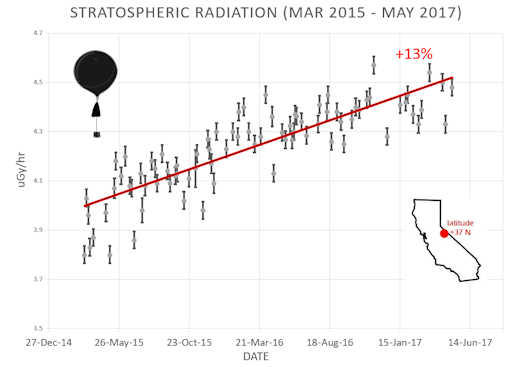
Why are cosmic rays intensifying? The main reason is the sun. Solar storm clouds such as coronal mass ejections (CMEs) sweep aside cosmic rays when they pass by Earth. During Solar Maximum, CMEs are abundant and cosmic rays are held at bay. Now, however, the solar cycle is swinging toward Solar Minimum, allowing cosmic rays to return. Another reason could be the weakening of Earth's magnetic field, which helps protect us from deep-space radiation. The radiation sensors onboard our helium balloons detect X-rays and gamma-rays in the energy range 10 keV to 20 MeV. These energies span the range of medical X-ray machines and airport security scanners. The data points in the graph above correspond to the peak of the Reneger-Pfotzer maximum, which lies about 67,000 feet above central California. When cosmic rays crash into Earth's atmosphere, they produce a spray of secondary particles that is most intense at the entrance to the stratosphere. Physicists Eric Reneger and Georg Pfotzer discovered the maximum using balloons in the 1930s and it is what we are measuring today. | | The official U.S. government space weather bureau | | | The first place to look for information about sundogs, pillars, rainbows and related phenomena. | | | Researchers call it a "Hubble for the sun." SDO is the most advanced solar observatory ever. | | | 3D views of the sun from NASA's Solar and Terrestrial Relations Observatory | | | Realtime and archival images of the Sun from SOHO. | | | from the NOAA Space Environment Center | | | fun to read, but should be taken with a grain of salt! Forecasts looking ahead more than a few days are often wrong. | | | from the NOAA Space Environment Center | | | the underlying science of space weather |  | If you are a Youtuber and want to buy real Youtube views than try out Buyrealsocial.com for the best results possible! |  | To find reviews of new online casino sites in the UK try The Casino DB where there are hundreds of online casino reviews complete with bonuses and ratings. | | | These links help Spaceweather.com stay online. Thank you to our supporters! | | | | | | | | |  | |  |   | ©2017 Spaceweather.com. All rights reserved. This site is penned daily by Dr. Tony Phillips. | |

